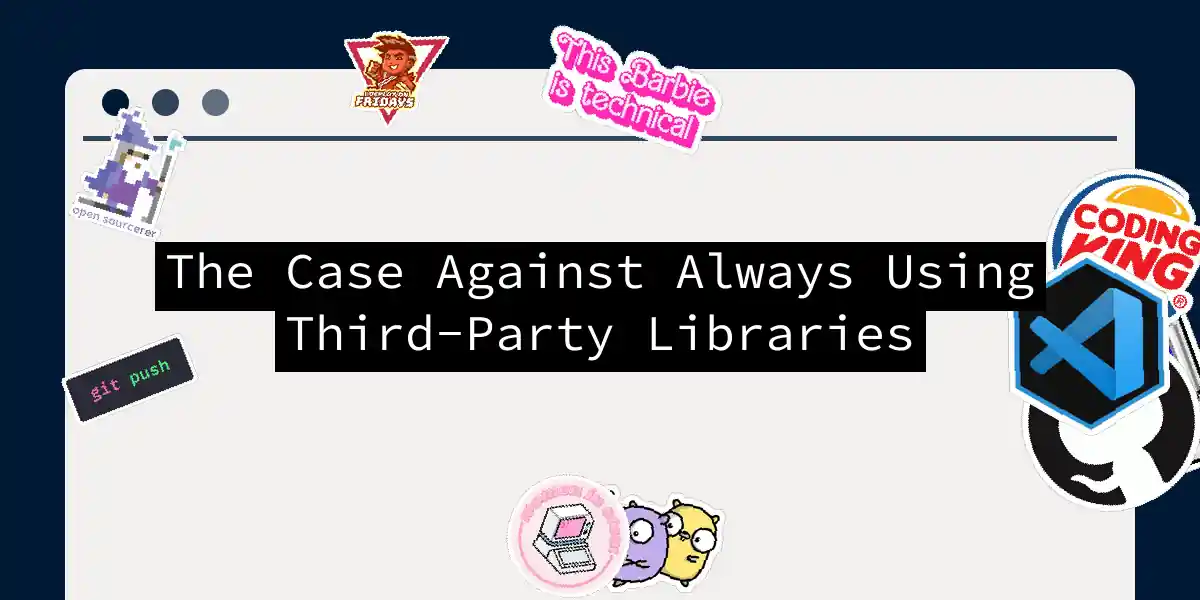When it comes to software development, the allure of third-party libraries is hard to resist. They promise to save time, reduce costs, and accelerate the development process. However, beneath the surface of these benefits lies a complex web of potential pitfalls that can jeopardize the integrity, security, and maintainability of your software.
The Siren Song of Third-Party Libraries
Third-party libraries are like the sirens of the software world, luring developers with the promise of easy solutions to complex problems. They offer pre-written code that can be integrated into your project with minimal effort, allowing you to focus on other aspects of development. Here are some of the key advantages that make them so appealing:
- Faster Development Process: With third-party libraries, you don’t have to reinvent the wheel. The code is already written, tested, and often optimized, which significantly speeds up your development cycle[1].
- Cost Savings: Many third-party libraries are free or low-cost, especially for open-source options. This can be a huge boon for projects with limited budgets[1].
However, these advantages come with a set of significant drawbacks that can make third-party libraries more of a liability than an asset.
The Hidden Dangers
Security Risks
One of the most critical concerns with third-party libraries is security. These libraries can introduce vulnerabilities into your application that you may not even be aware of. For instance, if a library has a security flaw, it can become a target for hackers, compromising your entire system. The infamous case of the sabotaged npm package that wiped files in Russia and Belarus is a stark reminder of these risks[1][4].
Dependency Issues
When you use third-party libraries, you are at the mercy of the library’s maintainers. Any breaking updates or changes in the library can disrupt your application, requiring immediate attention and potentially causing downtime. This dependency can be particularly problematic if the library is no longer maintained or if the maintainers decide to change the API in a way that breaks your code[1].
Lack of Flexibility
Third-party libraries often come with predefined functionalities that may not perfectly align with your specific needs. Customizing these libraries can be a daunting task, requiring significant effort and sometimes even rewriting parts of the library. This inflexibility can limit your ability to innovate and tailor the software to your exact requirements[1].
Unexpected Bugs
Even well-maintained libraries can have edge cases that cause unexpected bugs. These bugs can be particularly challenging to debug because they are buried deep within the library’s codebase. The time and effort required to identify and fix these issues can be substantial, often outweighing the initial time saved by using the library[1].
Mitigating the Risks
While the risks associated with third-party libraries are real, they are not insurmountable. Here are some strategies to help mitigate these risks:
Vet Your Libraries
Before integrating a third-party library, it is crucial to vet it thoroughly. Check the library’s reputation, read reviews, and look at the community support. Ensure that the library is actively maintained and has a good track record of security updates[1][4].
Manual Source Code Review
For critical components, consider performing a manual source code review. This can help identify potential security vulnerabilities and other issues before they become problematic. Static analysis tools and peer review can also be invaluable in this process[4].
Use Short-Lived Dependencies
When possible, use short-lived dependencies or version pinning to avoid unexpected changes in the library. This approach can help you maintain control over the versions of the libraries you use and reduce the risk of breaking changes[1].
A Personal Anecdote
I recall a project where we decided to use a popular third-party library for authentication. Initially, it worked like a charm, saving us weeks of development time. However, when the library’s maintainers released a major update, our application broke in ways we never anticipated. The update changed several key APIs, and we had to scramble to fix the issues. It was a painful lesson in the importance of careful dependency management.
Diagram: Dependency Management Flow
Conclusion
While third-party libraries can be incredibly useful, they should not be used blindly. Each library must be carefully evaluated for its potential risks and benefits. By understanding these risks and implementing strategies to mitigate them, you can ensure that your software remains secure, maintainable, and flexible.
In the end, the decision to use a third-party library should be based on a thorough analysis of your project’s needs and the potential impact of the library on your software. Remember, saving time upfront can sometimes cost you dearly in the long run. So, the next time you reach for that shiny new library, take a moment to consider whether it’s really worth the risk.
